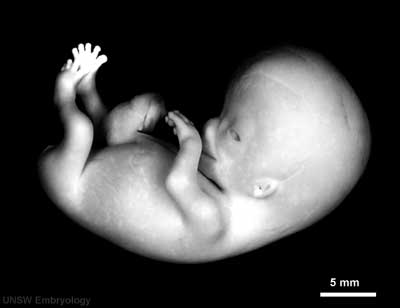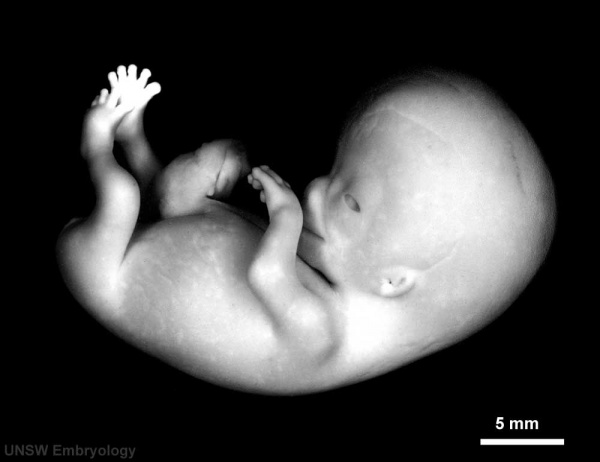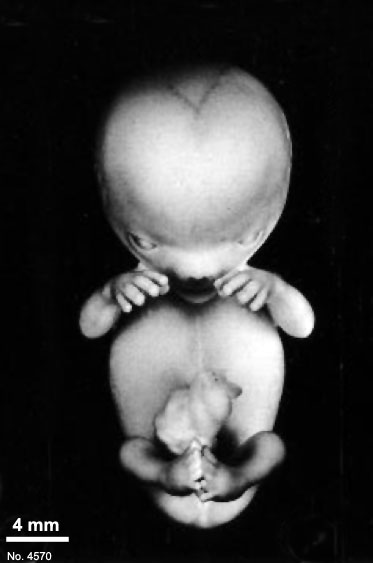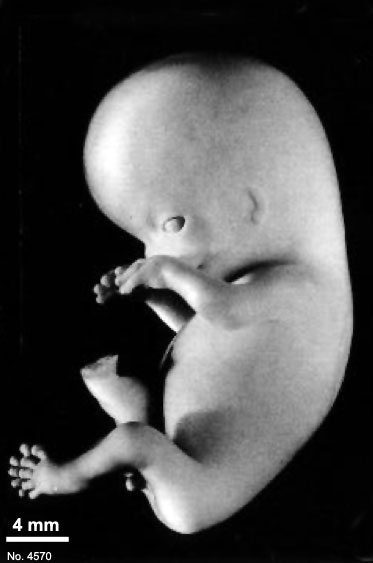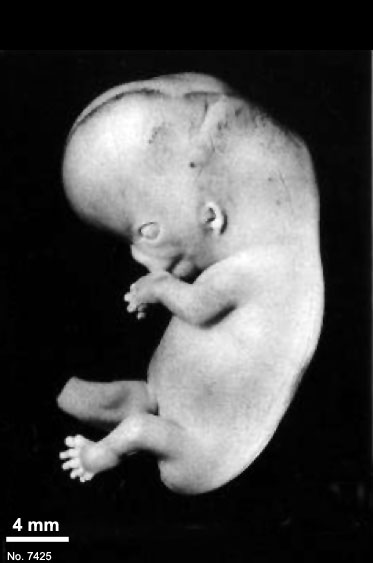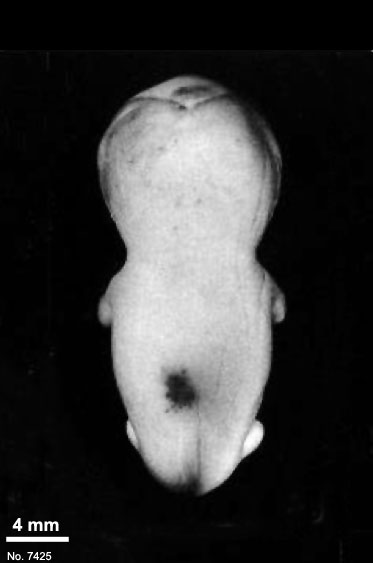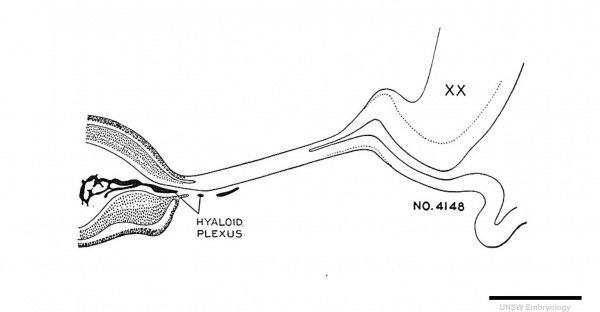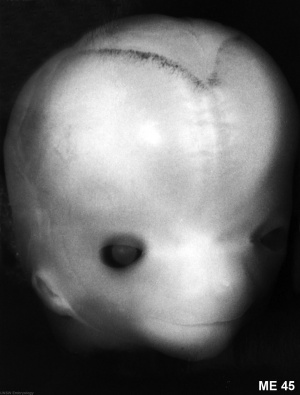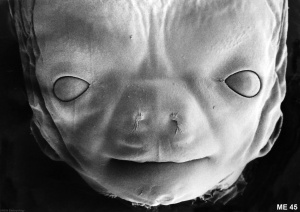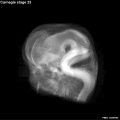Carnegie stage 23
| Embryology - 24 Apr 2024 |
|---|
| Google Translate - select your language from the list shown below (this will open a new external page) |
|
العربية | català | 中文 | 中國傳統的 | français | Deutsche | עִברִית | हिंदी | bahasa Indonesia | italiano | 日本語 | 한국어 | မြန်မာ | Pilipino | Polskie | português | ਪੰਜਾਬੀ ਦੇ | Română | русский | Español | Swahili | Svensk | ไทย | Türkçe | اردو | ייִדיש | Tiếng Việt These external translations are automated and may not be accurate. (More? About Translations) |
Introduction
This is the final Carnegie stage of embryonic development in Week 8. After this development is considered fetal for the remainder of the pregnancy.
Facts
Week 8, 56 - 60 days, 27 - 31 mm
Gestational age GA week 10
Summary
- Ectoderm:
- Mesoderm: ossification continues
- Head: eyelids, external ears, rounded head
- Body: straightening of trunk, intestines herniated at umbilicus
- Limbs: hands and feet turned inward
See also Carnegie stage 23 Events
Features
- scalp vascular plexus, eylid, eye, nose, auricle of external ear, mouth, shoulder, arm, elbow, wrist, toes separated, sole of foot, umbilical cord
- hearing - cochlea shows nearly 2.5 turns, otic capsule cartilage separated from the semicircular ducts by a pre cartilaginous zone. Labyrinth has practically completed its gross development and ductus reuniens is well defined.[1]

|
In 1949 the embryologist George Streeter[2] used the replacement of cartilage within the humerus by bone marrow as an arbitrary definition of the embryo to fetus transition.
|
| Week: | 1 | 2 | 3 | 4 | 5 | 6 | 7 | 8 |
| Carnegie stage: | 1 2 3 4 | 5 6 | 7 8 9 | 10 11 12 13 | 14 15 | 16 17 | 18 19 | 20 21 22 23 |
- Carnegie Stages: 1 | 2 | 3 | 4 | 5 | 6 | 7 | 8 | 9 | 10 | 11 | 12 | 13 | 14 | 15 | 16 | 17 | 18 | 19 | 20 | 21 | 22 | 23 | About Stages | Timeline
Kyoto Collection
View: This is a dorsolateral view of embryo. Amniotic membrane removed.
Oral Cavity
- Oral Cavity (stage 23)
Movies
| Carnegie Stage 23 MRI movies | |||||||||||||||||||||||||||
|---|---|---|---|---|---|---|---|---|---|---|---|---|---|---|---|---|---|---|---|---|---|---|---|---|---|---|---|
|
|
|
|
|
|
| |||||||||||||||||||||
| |||||||||||||||||||||||||||
Image source: The Kyoto Collection images are reproduced with the permission of Prof. Kohei Shiota and Prof. Shigehito Yamada, Anatomy and Developmental Biology, Kyoto University Graduate School of Medicine, Kyoto, Japan for educational purposes only and cannot be reproduced electronically or in writing without permission.
Carnegie Collection
- Carnegie stage 23: 4570 right | 4570 anterior | 4570 left | 4570 posterior | 4570 large right | 4570 large left | Rotation | Carnegie Embryos
| Carnegie Collection - Stage 23 | |||||||||||
|---|---|---|---|---|---|---|---|---|---|---|---|
| Serial No. | Size (mm) | Grade | Fixative | Embedding Medium | Plane | Thinness (µm) | Stain | Point Score | Sex | Year | Notes |
| 45 | E,28 Ch, 40x35x20 | Poor | ? | P | Coronal/Transverse | 50 | Al. coch. | 51.5 | Female | 1895 | |
| 75 | E,30 | Good | Alc. | P | Sagittal | 50 | Coch. | 57 | Male | 1897 | |
| 86 | E,30 | Good | ? | ? | Coronal | 50 | Coch. | Male | 1897 | May be an early fetus | |
| 100 | E,27 | Poor | ? | P | Sagittal | 50 | Al. coch. | 57.5 | ? | 1897 | |
| 108 | E, 28 (est.) | Poor | Piurosulph. acid | P | Sagittal | 45 | Borax carm. | 52.5 | Male | 1897 | |
| 227 | E30 Ch, 60x40x20 | Poor | Formalin | P | Sagittal | 50, 100 | Al. coch. | 54 | Female | 1903 | |
| 417 | E,32 Ch., 0x60x40 | Good | Formalin | P | Transverse | 100 | Al. coch. | 58.5 | Female | 1907 | |
| 756A | E, 27 Ch. 60x45x35 | Good | Formalin | P | Coronal | 50 | Al. coch. | 56 | Male | 1913 | |
| 882 | E , 28 Ch, 80x80x40 | Good | Formalin | P | Transverse | 40 | Multiple | 53 | 8 | 1913 | |
| 950 | E, 29 | Good | Formol | P | Transverse | 50 | Al. coch. | 54 | Male | 1914 | |
| 1199 | E.,26 Ch,, 60x40x30 | Good | Formalin | C | Coronal | 40 | (Stain - Haematoxylin Eosin) aur , or. G. | 54.5 | Male | 1915 | |
| 1535 | E , 28 Ch. 50x45 x15 | Poor | Formalin | P | Transverse | 40 | (Stain - Haematoxylin Eosin) | 495 | Female | 1916 | |
| 1945 | E., 27.3 Ch., 83x53x22.5 | Good | Formalin | C-P | Transverse | 50 | (Stain - Haematoxylin Eosin) aur., or. G. | 48 | Male | 1917 | |
| 2561 | E., 27 .5 | Good | Formalin | C-P | Transverse | 25 | (Stain - Haematoxylin Eosin) aur., or. G. | 48 .5 | Male | 1919 | |
| 4205 | E., 29.5 | Good | Bouin | P | Transverse | 50 | A1. coch. | 55.5 | Female | 1923 | |
| 4289 | E., 32.2 Ch., 52x35x25 | Good | Formalin | P | Transverse | 15, 20 | A1. coch., Mallory | 59 | Female | 1923 | |
| 4525 | E., 30 | Good | Formalin | P | Sagittal | 20 | (Stain - Haematoxylin Eosin) | 57 | Male | 1924 | |
| 4570 | E, 30.7 Ch., 52X50X28 | Exc. | Bouin | P | Transverse. | 15 | (Stain - Haematoxylin Eosin) , phlox. | 55 | Male | 1924 | |
| 5154 | E.,32 | Good | Bouin | P | Transverse | 20 | (Stain - Haematoxylin Eosin) | 59.5 | Male | 1926 | |
| 5422 | E., 27 | Good | Formalin | P | Sagittal | 40 | (Stain - Haematoxylin Eosin) | 52.5 | Female | 1927 | |
| 5621A | E., 27.5 | Good | Formalin | P | Transverse | 20 | (Stain - Haematoxylin Eosin) | 52.5 | Male | 1927 | Other twin has spina bifida and fused kidneys |
| 5725 | E, 23 | Good | Formalin | P | Coronal | 25 | (Stain - Haematoxylin Eosin) aur., or. G. | 50.5 | Female | 1928 | |
| 6573 | E,31.5 | Good | Bouin | C | Transverse | 20 | (Stain - Haematoxylin Eosin) | 58.5 | Female | 1932 | |
| 7425 | E, 27 | Exc. | Bouin | C-P | Coronal | 20 | (Stain - Haematoxylin Eosin) | 47 | Female | 1937 | Ag added |
| 9226 | E, 31 | Exc. | Formalin | C—P | Transverse | 12 | Azan | ? | Female | 1954 | |
| D.122 | E, 27 | Exc. | ? | ? | Transverse | 19 | Ag | ? | ? | 1976 | Yntema and Truex |
Abbreviations
| |||||||||||
| iBook - Carnegie Embryos | |
|---|---|
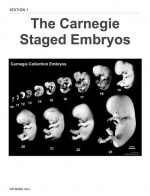
|
|
Hill Collection
| Hill HH12 | |
|---|---|
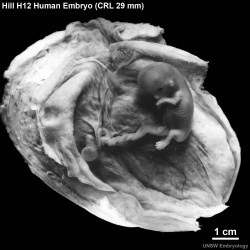
|
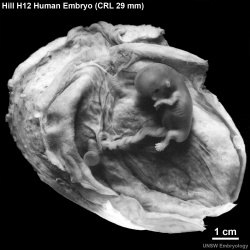
|
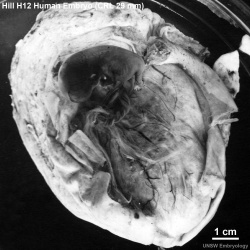
|
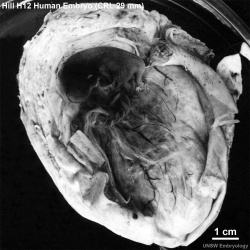
|
- Links: Hill Collection
Madrid Collection
| Madrid Collection Embryos | ||||||
|---|---|---|---|---|---|---|
| Carnegie Stage |
Embryo | Days | CRL (mm) | Section thickness |
Staining | Section plane |
| 23 | Mes-2 | 56 | 27 | 10 | (Stain - Haematoxylin Eosin)-trichrome | Frontal |
| 23 | C11 | 57 | 28 | 10 | (Stain - Haematoxylin Eosin)-trichrome | Transverse |
| 23 | Bot 4 | 58 | 29 | 10 | Bielschowsky (Stain - Haematoxylin Eosin) | Transverse |
| 23 | CA 4 | 59 | 31 | 10 | (Stain - Haematoxylin Eosin) | Frontal |
Hinrichsen Collection
Stage 23 Human Embryo (ME45) 31 mm Face. Note the SEM ventral view of the embryo.
Domenech-Mateu Collection
Stage 23 Human Embryo (E109) 30 mm Abdomen, thorax
| Domenech-Mateu Collection Embryo - E109 | ||||||
|---|---|---|---|---|---|---|
| Carnegie Stage |
Embryo | Original | CRL (mm) | Section thickness |
Staining | Section plane |
| 23 | E109 | Bi-1 | 30 | 10 | ?? | Sagittal |
| Links: Carnegie Stage 23 | Domenech-Mateu Collection | DEC - Domenech-Mateu Collection | ||||||
Events
- Head Development[3]
- superficial vascular plexus - has spread nearly to the vertex of the head.
- limb[3]
- length - considerable growth occurred in two days.
- forearm - sometimes raised to a level above that of the shoulder
- hands - extend far out in front of the embryo.
- humerus - All five cartilaginous phases are now present[2] (Streeter, 1949, figs. 3 and 18).
- vision
- retina comprises the pigmented layer, external limiting membrane, proliferative zone, external neuroblastic layer, transient fiber layer, internal neuroblastic layer, nerve fiber layer, and internal limiting membrane. Eyelids closure is complete (Note - shown as still open in the Kyoto embryo).[4]
- cornea now comprises the anterior epithelium and its basement membrane, the substantia propria, and the posterior epithelium (Streeter, 1951, fig. 18, and O’Rahilly, 1966[5], figs. 51 and 59).
- Optic nerve a vascular canal is present and sheath in the more advanced specimens (O’Rahilly, 1966[5] , fig. 55).
- smell
- the olfactory strands are well individualized, and olfactory and terminal-vomeronasal fibers are easily distinguishable.[6] Stages Description
- Vomeronasal organ - A narrow canal is seen in the long, tapering duct. The sac is beginning to shrink and retrogress.
- hearing - Cochlear duct tip now points “downward” for the second time. The duct is coiled to nearly its final extent of 2½ turns.
- submandibular gland - Long duct, much branched. Lumen deep in gland. Lumina in many terminal branches of ducts. Beginning orientation of epithelial tree. Angiogenesis beginning around epithelium. Mesoblast begins to form layer around gland.[3] Lumina are found in many terminal branches of the duct. Orientation of the epithelial tree is beginning, and angiogenesis is commencing around the epithelium. A mesodermal sheath is beginning to form around the gland.
- Renal - Metanephros secretory tubules are changing from short to long, and becoming more convoluted. The epithelium in some tubules is high. Renal tubules of fourth and fifth orders are present. Large glomeruli are numerous.
- endocrine[8]
- pituitary - adenohypophysis loss of the stalk and lobules of epithelium project into the mesodermal component of the gland, and oriented epithelial follicles are present (Streeter, 1951, plate 2). Abundant angioblasts and capillaries are found.
- pineal - pineal body has reached Stadium 5 of Turkewitsch (1933).[9]
- thymus - The cortex is well-developed, "true lobulation" has begun with the appearance of" fine superficial scallops," lymphocytes are present sparsely in the subcortical zone, and vessels are found within the thymus (Norris 1938).
- adrenal
- Adrenal Cortex - It appears that C2 cells first enter the body of the gland at this stage. The pattern of the arterial supply is established. The cellular "capsule" is penetrated by arterial capillaries which join the sinusoids. Their points of entry give the surface of the gland an appearance of cobblestones. The zona glomerulosa is formed of CI and C3 cells. Cells from this zone and from the "capsule" migrate centrally into the cords.[10]
- Adrenal Medulla - Nerve fibres and neuroblasts are first seen in the body of the gland. The paragangtion (M3) cells are beginning to multiply rapidly and, from 30 mm (stage 23) until birth, some are differentiating into chromaffin cells.[10]
- meninges (spinal cord) - dura mater may be followed completely around the inner wall of vertebral canal. Ventral dura rudiment is a densely cellular band of tissue with most medial parts in direct contact with tissues associated with dorsal surfaces of centra and intervertebral disks. Stratified cells lying on dorsal surface of centra and intervertebral disks can be separated into three layers: an outer perichondrial layer adjacent to cartilaginous tissue; an intermediate layer more restricted in transverse extent and ultimately forms dorsal longitudinal ligament; and an inner layer the ventral dura rudiment.[11]
- genital[12]
- testis Testicular tubules are visible.[13] The rete testis makes contact but no actual union with the mesonephric elements[14]. The urogenital union occurs in the fetal period. Clusters of cells begin differentiation into the interstitial cells.[15]
- ovary Rete ovarii closely related to, but not united with, mesonephric elements.[14]
- uterus Paramesonepltric ducts meet the urogenital sinus and fuse together in the median plane. [16][17] The sinusal (Mullerian) tubercle has appeared>[16]
- External genitalia developed not sufficently for sex detection.[18]
- skeletal muscle[19] skeletal muscles of the trunk and limbs could be individually identified in their relative adult position. Pectoralis major muscle was divided in three separate muscle heads. Highly developed extraocular, infrahyoid and suprahyoid muscles. Absence of the facial muscles that have been described to be present at this stage of development.
- ventral body wall - rectus muscles reach the umbilicus.[21]
References
- ↑ Streeter GL. On the development of the membranous labyrinth and the acoustic and facial nerves in the human embryo. (1906) Amer. J Anat. 6:139-165.
- ↑ 2.0 2.1 Streeter GL. Developmental horizons in human embryos (fourth issue). A review of the histogenesis of cartilage and bone. (1949) Carnegie Instn. Wash. Publ. 583, Contrib. Embryol., 33: 149-169. PMID: 18144445
- ↑ 3.0 3.1 3.2 3.3 Streeter GL. Developmental Horizons In Human Embryos Description Or Age Groups XIX, XX, XXI, XXII, And XXIII, Being The Fifth Issue Of A Survey Of The Carnegie Collection. (1957) Carnegie Instn. Wash. Publ. 611, Contrib. Embryol., 36: 167-196.
- ↑ Pearson AA. (1980). The development of the eyelids. Part I. External features. J. Anat. , 130, 33-42. PMID: 7364662
- ↑ 5.0 5.1 O'Rahilly R. The early development of the eye in staged human embryos. (1966) Carnegie Instn. Wash. Publ. 625, Contrib. Embryol., 38: 1-42.
- ↑ Bossy J. Development of olfactory and related structures in staged human embryos. (1980) Anat. Embryol., 161(2);225-36 PMID 7469043
- ↑ Mérida-Velasco JA, Sánchez-Montesinos I, Espín-Ferra J, Mérida-Velasco JR, Rodríguez-Vázquez JF & Jiménez-Collado J. (1997). Development of the human knee joint ligaments. Anat. Rec. , 248, 259-68. PMID: 9185992
- ↑ O'Rahilly R. The timing and sequence of events in the development of the human endocrine system during the embryonic period proper. (1983) Anat. Embryol., 166: 439-451. PMID 6869855
- ↑ O'Rahilly R. The development of the epiphysis cerebri and the subcommissural complex in staged human embryos. (1968) Anat. Rec., 160: 488-489.
- ↑ 10.0 10.1 Crowder RE. The development of the adrenal gland in man, with special reference to origin and ultimate location of cell types and evidence in favor of the "cell migration" theory. (1957) Contrib. Embryol., Carnegie Inst. Wash. 36, 193-210.
- ↑ Sensenig EC. The early development of the meninges of the spinal cord in human embryos. (1951) Contrib. Embryol., Carnegie Inst. Wash. Publ. 611.
- ↑ O'Rahilly R. (1983). The timing and sequence of events in the development of the human reproductive system during the embryonic period proper. Anat. Embryol. , 166, 247-61. PMID: 6846859
- ↑ Gillman J. The development of the gonads in man, with a consideration of the role of fetal endocrines and the histogenesis of ovarian tumors. (1948) Contr Embryol Carneg Instn. 32: 81-131.
- ↑ 14.0 14.1 Wilson KM. Origin and development of the rete ovarii and the rete testis in the human embryo. (1926) Carnegie Instn. Wash. Publ. 362, Contrib. Embryol., Carnegie Inst. Wash., 17:69-88.
- ↑ Pelliniemi LJ. and Niemi M. Fine structure of the human foetal testis. I. The interstitial tissue. (1969) Z Zellforsch mikrosk Anat 99: 507-522.
- ↑ 16.0 16.1 Koff A. Development of the vagina in the human fetus. (1933) Contrib. Embryol., Carnegie Inst. Wash. Publ. 443, 24: 59-60.
- ↑ Pillet J. Reconstruction des organes pelviens d’embryons humains de 12,5 et de 25 mm CR. (1967) Ass Anat 51: 819-827.
- ↑ Wilson KM. Correlation of external genitalia and sex-glands in the human embryo. (1926) Carnegie Instn. Wash. Publ. 363, Contrib. Embryol., Carnegie Inst. Wash. 18: 23-30.
- ↑ Warmbrunn MV, de Bakker BS, Hagoort J, Alefs-de Bakker PB & Oostra RJ. (2018). Hitherto unknown detailed muscle anatomy in an 8-week-old embryo. J. Anat. , , . PMID: 29726018 DOI.
- ↑ Kishimoto H, Yamada S, Kanahashi T, Yoneyama A, Imai H, Matsuda T, Takeda T, Kawai K & Suzuki S. (2016). Three-dimensional imaging of palatal muscles in the human embryo and fetus: Development of levator veli palatini and clinical importance of the lesser palatine nerve. Dev. Dyn. , 245, 123-31. PMID: 26509917 DOI.
- ↑ Mekonen HK, Hikspoors JP, Mommen G, Köhler SE & Lamers WH. (2015). Development of the ventral body wall in the human embryo. J. Anat. , 227, 673-85. PMID: 26467243 DOI.
Additional Images
Historic Images
| Historic Disclaimer - information about historic embryology pages |
|---|
| Pages where the terms "Historic" (textbooks, papers, people, recommendations) appear on this site, and sections within pages where this disclaimer appears, indicate that the content and scientific understanding are specific to the time of publication. This means that while some scientific descriptions are still accurate, the terminology and interpretation of the developmental mechanisms reflect the understanding at the time of original publication and those of the preceding periods, these terms, interpretations and recommendations may not reflect our current scientific understanding. (More? Embryology History | Historic Embryology Papers) |
- Carnegie Stages: 1 | 2 | 3 | 4 | 5 | 6 | 7 | 8 | 9 | 10 | 11 | 12 | 13 | 14 | 15 | 16 | 17 | 18 | 19 | 20 | 21 | 22 | 23 | About Stages | Timeline
Cite this page: Hill, M.A. (2024, April 24) Embryology Carnegie stage 23. Retrieved from https://embryology.med.unsw.edu.au/embryology/index.php/Carnegie_stage_23
- © Dr Mark Hill 2024, UNSW Embryology ISBN: 978 0 7334 2609 4 - UNSW CRICOS Provider Code No. 00098G
